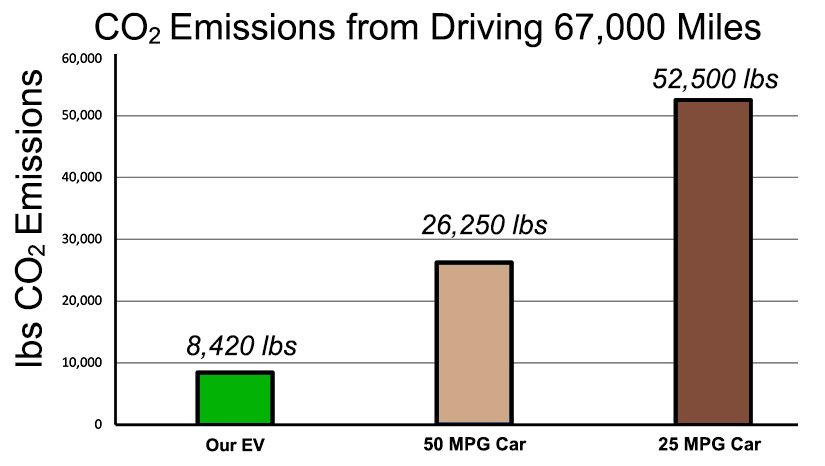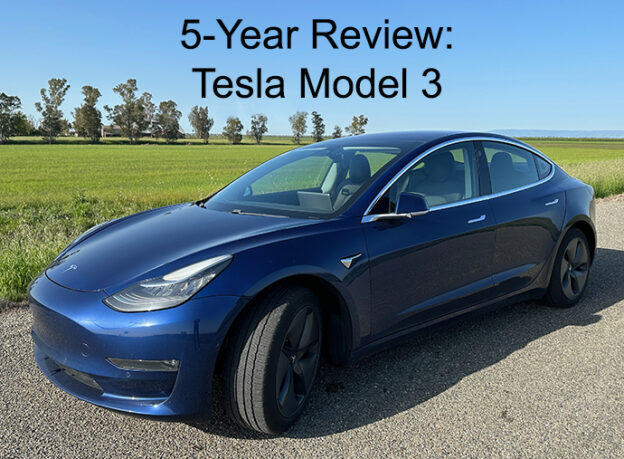April 2023. California. Part 6 of my 5-year review on the Model 3
We’ve just completed 5 years of driving our 2018 Model 3. This post estimates energy use and carbon emissions from charging our electric car. I calculated the amount of CO2 released from power plants to generate electricity to charge our car using data published by the US Energy Information Administration.
Energy Use
The Model 3 reports kWh used from the battery pack, but that number does not include energy used by the car while it is parked. As a result, while my car reported using over 13,000 kWh from the battery pack while driving, the actual amount of energy used was higher. Two main reasons: 1) the reported kWh usage does not reflect the amount of energy sent to the pack ‘from the wall’ during charging – that process is not 100% efficient; 2) Reported kWh usage does not take into account energy used by the car while parked for battery pack temperature management, cabin temperature regulation, and Sentry mode.

I started with the amount of Energy reported while driving (see above), and worked from there. I obtained the amount of energy sent to my car during Supercharging from my Tesla account – quick work since I don’t use Superchargers that often. The remainder of my charging was from 240 Volt Level 2 charging with few exceptions (120 Volt charging a few times). I considered Supercharging to be 92% efficient and 240 Volt charging at 85% efficient (i.e. only 85% of the electricity sent to the car ended up stored in the battery pack). I added 1 kWh per day used while the car was parked. From these calculations I estimated that the amount of electricity sent to my car ‘from the wall’.
I drove 67,000 miles and consumed 17,300 kWh of electricity to charge the car’s battery pack. 17,300 kWh of electricity over 5 years, or about 3,500 kWh of electricity to charge my car each year.
The Model 3 is an efficient EV. On the pic of the odometer above you can see I’m using 196 Wh/mile over the life of the car, or getting just over 5 miles per kWh from the pack. When you add in all the energy used to charge the car and energy used while parked I estimate that I’ve been using ~260 Wh/mile or inversely getting about 3.85 miles per kWh. FWIW, one gallon of gas contains the energy equivalent of 33.7 kWh of electricity. So 17,300 kWh ÷ 33.7 kWh/gallon = 514 gallons of gas. So I used the equivalent of 514 gallons to drive 67,000 miles = 130 eMPG in terms of energy used. For another comparison, I traded in a 2010 Prius to get the Model 3. The same style of driving in the Prius got me 53 MPG and I would have burned through 1265 gallons to drive 67,000 miles.
Emissions
In my opinion, the more important way to evaluate the impact of driving an EV is to compare the emissions from charging an EV with the emissions from driving a gas-powered car. To calculate carbon emissions I obtained data published by the US Energy Information Administration. Their website provides annual data on carbon emissions (and other pollutants) from electric power plants that are presented as an average for each state. From the number of kWh sent to my car I calculated CO2 released from power plants to generate that electricity. I took a couple trips where I charged my car in Nevada, Arizona, New Mexico, and Utah. I took that into account by using the EIA emissions data for those states on those trips.
Charging our EV to drive 67,000 miles released 8,420 lbs of CO2. For comparison, gas-powered cars emit 19.6 lbs of CO2 per gallon of gas burned. A 50 MPG car would burn through 1334 gallons of gas to drive 67,000 miles and would therefore spew over 26,000 lbs of CO2 into the atmosphere. So our EV released ⅓ of the emissions compared to a 50 MPG Prius, and only ⅙ the carbon emissions of the average 25 MPG car (52,250 lbs). Note that electric power plants release other pollutants into the atmosphere, but CO2 makes a large contribution compared to other factors that drive climate change.

8,420 is not zero, but it’s a step in the right direction. More EVs on the market, more affordable choices, and more information about how EVs work should increase the percentage of lower emission cars on the road and help us reduce green house gas emissions from personal transportation.

This is Part 6 of my 5-year review. The review is broken up into short posts on different aspects of owning the Model 3. Additional posts will be linked below as they go live. Topics will cover:
- 1. Day 1
- 2. My opinion on the car
- 3. Quality & Reliability
- 4. Battery Pack Status
- 5. Charging
- 6. Emissions
- 7. FSD
Note: In addition to energy used while driving any type of car, manufacturing and upstream emissions must be taken into account. As explained by the US Dept of Energy, gasoline and electricity fuel pathways have upstream emissions from extraction, refining, production, and transportation of the fuel. Emissions from vehicle manufacture and end of life must also be considered. A future post will examine this topic in greater detail.

